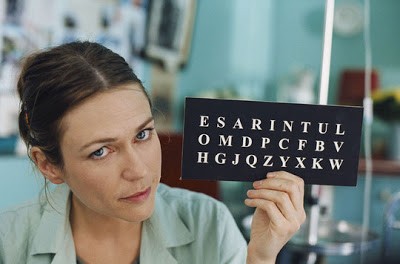-
Julien schnabel: The diving bell and the butterfly (2007)
JULIAN SCHNABEL: THE DIVING BELL AND THE BUTTERFLY

MARIE-JOSEE CROZE IN THE DIVING BELL AND THE BUTTERFLY
In the blink of an eye
Julian Schnabel’s brilliantly fractured acid-trip vision informs the best sequences of this film about Jean-Dominique Bauby, based on his eponymous book and veteran screenplay adaptor Ronald Haywood’s treatment. Bauby, “Jean-Do” to his friends and family, was at the top of his not inconsiderable game in his early forties, father of a cute boy and girl, lover, writer, and, most notably, editor of the fashion magazine Elle.
Then, Jean-Do woke up from a coma trapped in his body following a massive stroke, “locked in” by total paralysis. The English words are used by French doctors, and Schnabel wisely had Haywood’s screenplay translated into French and made the film in Bauby’s language and shot it where the events took place.
Maybe nothing later can match the empathy and shock of that first sequence, seen through a special "swing and tilt" lens (augmented by Schnabel’s own eyeglasses) refracting images in and out of focus and in and out of Jean-Do’s limited range of view, when he first comes out of his coma and the doctor tells him where he is and what has happened to him. He can see only what’s in front of him. Spielberg collaborator Janusz Kaminiski was the D.P.—one of many top-ranking collaborators: together with the other actors and Amalric’s voice (heard in his head: he can’t speak) to make this moment intensely, unsentimentally, almost beautifully real to us.
Finally Matthieu Amalric’s big bulging eyes are about to come into their own, except the doctors “occlude” (sew shut) one of them because it’s in danger of drying up. We see this from the protagonist’s P.O.V. as we see everything for a while. These early scenes are stunning, accomplished, and fresh. Remember when Schnabel showed a room as Basquiat saw it stoned? This is that, in spades.
Bauby, Harwood, Schnabel—and the Berck Maritime Hospital where Baugy was actually cared for: this is the fourth principal element behind the success of The Diving Bell and the Butterfly. (The French title is Le Scaphandre et le papillon. ) Bauby’s real life caregivers appear in the picture and were consulted at every stage in the shooting at the hospital on how he looked and how he was cared for: the film balances wild invention with faithfulness to fact. The fifth element is a magnificent cast, with Amalric as Bauby, Emmanuelle Seigner, Anne Cobigny, Marie-Josee Croze, Patrick Cervais, Niels Arestrup, Jean-Pierre Cassel, Maria Hands, Max von Sydow (as Bauby’s father) and Schnabel’s wife Olatz Lopez Garmendia.
A speech therapist teaches the paralyzed Jean-Do to "speak" by blinking his eye to choose letters. He is despairing at first: his initial sentence is 'I want to die." But he has spunk, and he also has irony, anger, energy and will. And everybody around him is extraordinarily kind. We may have cause to remember that in the UN study Michael Moore cites in Sicko, the French medical system came out number one. But family and friends rally round and behave commendably too.
So the patient gains heart and decides to write a book, even though he must still use this slow, painstaking method that he learned with his speech therapist. He already has a contract for one, but he changes the subject to this overwhelming experience he is undergoing and all the thoughts and images that flow through him, which become a kind of poem about life and about his own life. His publisher finds an especially kind and patient collaborator. And she like the other women around him, is beautiful.
Jean-Do is trapped inside the diver’s bell (an image Schnabel and Amalric enact literally). But also he’s the butterfly because in memory and imagination he can flit anywhere, over mountain ranges, over decades.
A soundtrack uses Tom Waits, Singin' in the Rain, the 400 Blows theme, and other elements to pull together a wild flow of sequences with emotion and allusion. It’s a bit of a letdown to see Amalric sometimes, skillfully but still theatrically, impersonating the paralyzed Jean-Do directly onscreen. The film can be forgiven for occasionally failing to transform the ordinary and banal into the extraordinary because when it’s on point, it’s exhilarating to watch.
Bauby was a successful man, but his success and his life were of an ordinary kind. Writing a book one painfully chosen letter at a time was not ordinary, and he rose to the occasion in the thoughtfulness and originality of his text. This was not merely coping; it was transcending. It also gave Schnabel, coping with his mother’s death and his father’s fear of imminent demise when the project fell into his hands, a special opportunity to make a film that serves its subject faithfully and well, and at the same time is highly personal. The book became a bestseller. This film got Schnabel the Best Director award at Cannes this year.
This started off the press screenings of the New York Film Festival 2007.
Last edited by Chris Knipp; 08-08-2014 at 08:29 PM.
 Posting Permissions
Posting Permissions
- You may not post new threads
- You may not post replies
- You may not post attachments
- You may not edit your posts
-
Forum Rules





 Reply With Quote
Reply With Quote
Bookmarks